
You can take the girl out of the shop, but you can't take the shop out of the girl
For years I ran the sample sales for Christian Louboutin in London. Now, back in Geneva, …
I bought a new face cleanser, and that's big news. Not because of the product itself, but because of how I came to buy it. After years of ignoring CeraVe despite countless beauty roundups, one story changed everything. It wasn't more authoritative or better researched than the others. Better! I just saw myself in it.
This essay explores the difference between trusting a publication and trusting a story, why five-star reviews convince me but two-star ones don't, and what recognition teaches us about communication that actually moves people to action.

Last Sunday, I was minding my own business, enjoying my morning latte with the dog curled up against my right shin. My weekend's guilty pleasure is to read the papers. It's sooo British of me (IYKYK). The Guardian, the Times, and the Financial Times are all accessible via my iPad, plus the New York Times for good measure. Whether I'm on top of the fluffy throw covering my sofa, or under it, I delight in the decadence of those moments, simply because they are essentially anti-productive. Nothing is supposed to come out of that. Reading. Sipping. Cuddling. Resting.
However, there's a dreaded side effect: when one peruses so many newspapers and magazines, you'll likely be inspired to shop. PR product placement is alive and well, at least in my household.
That morning, I was gobbling up the Sunday Times Style magazine when I stumbled across an article by someone called Kristi Murison. In the space of a minute, I knew she was talking to ME.
The opening paragraphs talked about her sensitive skin, occasionally prone to itchy rashes. As I read on, she detailed the conversation she'd had with a new dermatologist, who asked a series of pointed questions:
'Do I flush often? Yes, it makes me extremely self-conscious.
Does it happen when I exercise? Yep, I turn a ridiculous shade of beetroot.
How about when I'm stressed? You betcha. If I move from a cold room into a hot one? Always!'
"I already knew when I first saw you, but everything you have since told me confirms it. You have rosacea," announced the doctor.
And in my head, my inner voice exclaimed: 'Oh… then I have that too!'
The rest of the article detailed approved products and a protocol to treat the dermatological condition, prominent in white-skinned, blue-eyed people of Celtic or European descent. Basically, me.
Not born yesterday, I sort of knew that I had rosacea. My cheeks were much redder when I was a teenager (check out the picture I posted on Instagram the other day to see for yourself). But no dermatologist ever told me I could do something about it. My biggest issue at the time was those pesky adolescent whiteheads, so I was prescribed Roaccutane and sent on my way.
Later, as the overly independent person I am, and like many women who've put acids and other high-end solutions on their skin for all the reasons one can imagine, I put down regular facial irritation to my irregular (and unfaithful) skincare regimen, rather than to a potential condition.
The trigger point for me in the article was the line about turning beetroot red when exercising.
However energetic, rested and athletic I may have been at any point in my life, I have ALWAYS turned this deep, painful-looking shade of purpley-red. You should see me after 90 minutes of tennis under the summer sun. Damn cute.
Not particularly impulsive, I opened a new tab in Safari to research the products Dr Anjali Mahto recommended. She pointed me towards two CeraVe cleansers.
Huh.
I'd heard about the brand multiple times, stood nose to nose with the product at local pharmacies, yet never purchased it. I'd read about it in beauty roundups without understanding the benefits or getting a hint it was great for me. Was I aware it was developed with the help of dermatologists? Nope. Did I know what their products were good for? Nope!
What I was keenly aware of: the large rectangular plastic packaging (not for me), the Americanised supermarket-type branding (not for me), combined with the price point (altogether confirming: not for me). Feel free to call me a snob at this point.
How wrong I was.
I love plenty of affordable products—French pharmacy brands like SVR, Bioderma, Avène. But there's a preciousness to my bias: French pharmacy brands are okay. American ones? Ugh, not for me!
Sometimes, it's what's in the bottle that counts—even when you're a design nut like I am.
Here's what fascinates me: I trust The Times and The Guardian institutionally—I believe their editorial standards, I know they're not out to deceive me. But that institutional trust doesn't automatically make me buy everything they recommend.
I'll read a five-star review and feel immediately convinced. A two-star review of a film I want to see? Doesn't stop me at all. I just think: "Not for them, maybe for me." Same publication, same reviewer even—but my trust shifts depending on whether they're expressing enthusiasm or dismissal.
With Kristi Murison's article, something different happened. It wasn't that I trusted her more than other beauty writers. It's that I saw myself in her story. The beetroot flushing when exercising. The self-consciousness. The conversation with the dermatologist.
I didn't need to trust her judgement about whether CeraVe was good. I recognised my own experience in her words—and that recognition moved me to act in a way that dozens of other well-researched, editorially sound beauty roundups never had.
As someone working at the intersection of communication, coaching, mindfulness, and storytelling, this selective resonance fascinates me. We can trust a publication completely and still not buy what they're selling. We can respect an expert's opinion without following their recommendations. But when we recognise ourselves in someone's story? That's when we move.
Which stories do we trust? Which voices do we dismiss? And what does that reveal about our biases—both the helpful ones that protect us from irrelevant information, and the limiting ones that keep us from discovering what we actually need?
Take CeraVe, for example, a subsidiary of the L'Oréal group, as I just discovered. Since trying their hydrating cleanser, I'm already such a loyal fangirl that I'd like to pitch them a new line with the same formulation, in new packaging, with a better communication strategy—so other people who care about what I care about can find this product sooner.
This example serves as a standout lesson in brand communication and the sustained power of both storytelling and PR.
(Caveat: human pictures are also pretty great.)
What brought me from disinterested, aware shopper to loyal fan who wants to help CeraVe with their communication (yes, really, call me!) is someone's true story. One where I recognised myself in her words. One that had me tripping over myself, rushing to get the product, knowing it was exactly what my skin needs.
I can bang on about how effective storytelling moves us to action, and perhaps you'll be unmoved.
Yet the proof is now taking up nearly half a shelf in my bathroom cabinet. When we talk about real stuff, we don't need to sugarcoat or sensationalise. We connect. We move the needle.
Human stories are how we learn without explanations.
I still trust my newspapers and magazines. Sure, I worked with some of these titles for years and recognise the names in the bylines regularly. I trust that their editorial teams aren't out there to get me. They report and tell stories. It works for me.
Push me to buy something and I'll run away—which is why Instagram advertising rarely works on me. But give me a good, honest story? I'll be all over it.
Thoughtful, genuine messaging moves me to action. And look at that, I'm also telling you about it!
Knowing how we relate to stories and opinions matters—whether you're a consumer, a service provider, or a brand expert. More than ever, we need to claim our sense of agency: notice how we feel, get to know what we like and dislike, so we can challenge our own biases and explore our blind spots.
We could all learn something from that, don't you think?

For years I ran the sample sales for Christian Louboutin in London. Now, back in Geneva, …

What happens when you meet a wiser, more loving version of yourself? When I first …

Last night I fumbled my own introduction—despite literally teaching storytelling. The …
